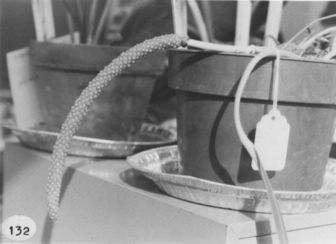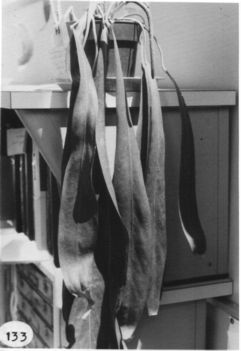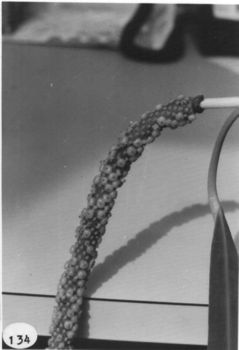






Anthurium pendens Croat, sp. nov.
TYPE: Panama. Colón: Santa Rita Ridge Road, along trail at end of road that goes to Río Indio, beginning 10.6 km from Transisthmian Hwy., 3 km beyond hydrographic station, ca. 380 m, Croat 34296A (MO 2815427, holotype; K, PMA, isotypes; Live at MO).
Planta pendens, epiphytica; cataphyllum persistens fibrosum, reticulum, grossum; petiolus teres, 8-22 cm longus; lamina coriacea, anguste linearis-oblanceolata, basi acuta, utrinque sparsim et inconspicuo glanduloso-punctata; inflorescentia effusa aut pendula; pe-dunculus tcres, 4.5-15 cm longus, spatha membranacea, viridulus-alba, oblonga ad oblongo-lanceolata, 7-7.5 cm longa, 1.5-2.5 cm lata; spadix roseus virides-cens brunneus, 12-18 cm longus; baccae aurantiacae, depresso-globosae, 5 mm longae.
Pendent epiphyte; stems ca. 10 cm long, 1-2.5 cm diam.; internodes to 2 cm long, shorter near apex; leaf scars 1.2 cm wide, often obscured by persistent cataphyll fibers; roots moderately thin, green; cataphylls moderately thick, 7-10 cm long, drying tan, weathering into coarse reticulate fibers.
LEAVES pendent: petioles 8-22 cm long, 4ų5 mm diam., terete, with reddish brown glands on surface; geniculum 0.5-1 cm long; blades coriaceous, narrowly linear-oblanceolate, long-acuminate at apex. acute at base, 41-75 cm long, 3-12.5 cm wide. usually broadest above middle; both surfaces matte to semiglossy, sparsely and inconspicuously glandular-punctate (conspicuous on drying); lower surface scarcely paler than upper surface; midrib acutely raised above, flat at apex, convexly raised below; primary lateral veins 8-12 per side, departing midrib at 10-20° angle, scarcely visible above or below, prominu-lous on drying; interprimary veins scarcely visible, drying as prominent as primary lateral veins; collective vein arising from the base, 3-15 mm from margin.
INFLORESCENCE spreading to pendent, much shorter than leaves; peduncle terete, 4.5-15 cm long 3.5-5 mm diam., as long as petioles; spathe thin, greenish white, oblong to oblong-lanceolate, 7-7.5 cm long, 1.5-2.5 cm wide, broadest at middle, abruptly acuminate at apex, obtuse to rounded at base, inserted at 35° angle on peduncle, usually withering early and deciduous; spadix pink, turning greenish brown before anthesis, 12-18 cm long, 5-8 mm diam. near base, 4-6 mm diam. near apex, the flowers square to rhombic, 2.9-4 mm wide, 2.9-3.5 mm long, the sides straight to sigmoid parallel to spirals, sigmoid perpendicular to spirals, 5-6 flowers visible in the principal spiral, 7-8 flowers visible in the alternate spiral; tepals semiglossy, the lateral tepals 1.8-2 mm wide, the inner margins broadly rounded; pistils weakly emergent; stigmas ellipsoid 0.4-0.6 mm long, with a small droplet apparent before stamens emerge; stamens emerging in a scattered manner usually beginning at the base but the laterals soon scattered throughout spadix, exserted on thin, clear filaments ca. 2 mm long, retracting to hold anthers close against pistil; anthers white, 0.5-0.6 mm long, 0.6-0.7 mm wide; thecae ovate, moderately divaricate; pollen white.
INFRUCTESCENCE pendent; spathe deciduous; spadix to 22 cm long with berries exserted; berries orange (B & K. Yellow 8/2.5), depressed globose, 5 mm long, 5 mm diam.; mesocarp gelatinous, yellow with numerous raphide cells; seeds (1-)2, pale yellow, ovoid, 2-2.7 mm long, 1-1.6 mm wide, with brownish appendage at base. Figs. 132, 133, and 134.
The species occurs in a small area on the border between Panama and Colombia (Choco). In Panama it is also known from Colón, Panama, and Darien Provinces at 100 to 450 m in tropical wet and lower montane rain forest. A collection from Cerro Sapo in Darien Province (Hammel 1199) is possibly also this species. It was collected at 830 m elevation and has a longer spadix (to 25 cm long) and a thin, papery epidermis loosely attached to the cataphyll fibers; its leaves match those of Anthurium pendens very well. Gentry & Folsom 7354, a collection from Colombia in the Department of Choco (Alto de Buey) at 1,200 to 1,800 m, may also be this species. I have seen only a sterile specimen, but the label indicates that it had a short brown inflorescence, which fits this species.
Anthurium pendens is a member of section Porphyrochitonium and is distinguished by very elongate, narrowly oblanceolate, pendent, glandular-punctate leaves (from whence it derives its name) that are acute at the base, dry markedly blackened and have the primary lateral veins departing midrib at an angle of 10-20°. It is also distinguished by its relatively short, straight, pinkish spadix that turns greenish brown before anthesis.
The species is closely related to Anthurium wendlingeri, which has similar, elongate, coriaceous, glandular-punctate blades with an identical texture and comparable punctations. The latter differs, however, in having blades that are oblong-linear, broadest near the middle or below the middle with a rounded base, with veins that depart the midrib at a 20-40° angle, and with blades that dry yellowish green, not at all blackened. Most importantly, it has a much longer, more slender inflorescence that is white to grayish at anthesis and soon coils into a helicoid spiral.
Smaller plants of Anthurium pendens have been confused with A. friedrichsthalii, but the former can be distinguished in that it has slightly broader blades that dry darker, and it tends to have stamens exposed on drying. Blades of A friedrichsthalii usually dry light greenish brown, and the anthers are strongly retracted on drying.
 |
 |
 |
Map of Mesoamerican specimens with coordinates
Panama Chiriquí:, 14 Mar. 1987, Walters 2220 (SEL). Panama Colón: 380
m,, 13 Apr. 1976, Thoams B. Croat 34296A (MO).
Panama Colón: Río Escandaloso, 100 - 200 m,, 19 Feb. 1986, Christenson
1212 (SEL).
Panama Darien: 550-760 m, 7.57N 77.46W, 28 June 1988, Thomas B. Croat
68887 (MO).
Panama Darien: 550-830 m, 7.58N 78.23W, 25 May 1991, Gordon McPherson
15384 (MO).
Panama Darien: 600-800 m, 7.59N 78.25W, 23 Mar 1986, Barry Hammel,
O. Franco, C. de Gaiza & J. Trainer 14831 (MO).
Panama San Blas: 350 m, 9.19N 78.55W, 8 March 1986, Greg de Nevers
& Heraclio Herrera 7280 (MO).
Panama San Blas: 350 m, 9.19N 78.55W, 6 Nov. 1984, Gred de Nevers 4205
(MO).
Map of South American Specimens with coordinates
Colombia Bolívar: Río Cauca, 20-80 m., 08.20N 74.30W, 5 Jul.
1987, Callejas et al. 4329 (NY).
Colombia Choco: 0-100 m, 06.05N 77.10W, 6 mayo 1990, César Barbosa
6453 (MO).